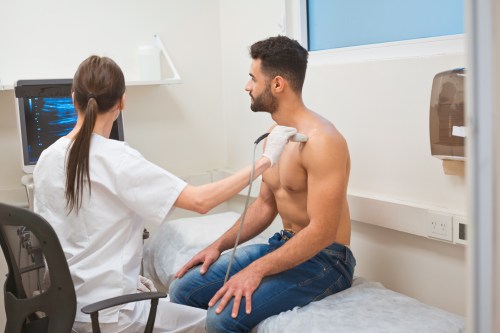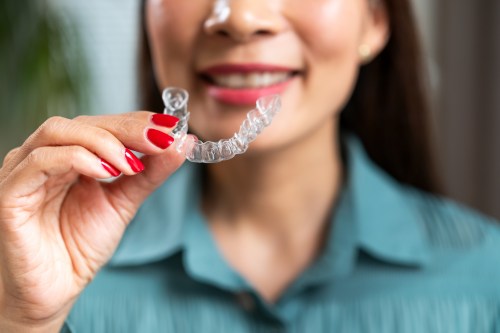Searches for “can men get breast cancer?” skyrocketed during Sunday’s Super Bowl LIX after Novartis, a pharmaceutical company, ran an ad focused on encouraging women to get screened for breast cancer. Called “Your Attention Please,” the commercial showed multiple close-ups of cleavage and women going about their daily lives before featuring a message from cancer survivor and comedian Wanda Sykes.
Experts in This Article
a breast surgical oncologist and director of the Margie Petersen Breast Center at Providence Saint John’s Center
chief of the Division of Breast Surgery at Fox Chase Cancer Center
chair for cancer research and a professor of medicine in the Department of Breast Medical Oncology at the University of Texas MD Anderson Cancer Center
“Early detection for breast cancer is a game-changer, and why I’m able to be here today,” Sykes says in the ad. “So let’s get more women screened than ever before.” While the commercial didn’t mention men, male breast cancer is a real thing—even though it often flies under the radar. Oncologists (or, doctors who specialize in treating cancer) say it’s crucial for everyone, regardless of gender, to be aware that breast cancer can happen to them, too. Here’s what healthcare providers who treat male breast cancer cases want you to know.
How common is male breast cancer—and why does it happen?
Male breast cancer is rare, making up about 1 percent of all breast cancer cases in the U.S., according to the National Breast Cancer Foundation. Still, it happens often enough. “I probably see a male breast cancer patient every month to every other month,” says Richard J. Bleicher, MD, chief of the Division of Breast Surgery at Fox Chase Cancer Center. “Most surgeons may see one male breast cancer patient a year.”
It's worth noting that people assigned female at birth are more likely to experience breast cancer due to higher levels of estrogen and progesterone (the two most common female hormones). These hormones can promote cell growth in the breast cells, including the growth of harmful cells like cancer. While people assigned male at birth don't have the same risk of breast cancer due to their hormone levels, there are other factors that can increase the risk of male breast cancer, per the Centers for Disease Control and Prevention (CDC):
- Aging
- Inherited genetic mutations that can increase breast cancer risk, like BRCA1 and BRCA2
- Family history of breast cancer
- Personal history of undergoing radiation therapy to the chest
- Taking medications that contain estrogen
- Living with health conditions that affect the testicles
- Having a diagnosis for Klinefelter syndrome (a rare genetic condition), liver disease, or obesity
Signs and symptoms to look for
Symptoms of breast cancer in men are often similar to those that women experience (e.g,. lump under the breast or nipple pain). However, men tend to experience some of these symptoms more often than others, says Janie Grumley, MD, a breast surgical oncologist and director of the Margie Petersen Breast Center at Providence Saint John’s Center in Santa Monica, CA.
“Men should look for any changes to the nipple,” Dr. Grumley says. “In men, breast cancer tumors commonly happen around the nipple because that’s where their breast tissue is predominantly located.” She lists scaling and retraction of the nipple (where it looks like the nipple is being pulled inward) as the most important symptoms to get checked out.
“Sometimes men will find a lump or swelling in the breast or under the arm, which can be a sign of breast cancer,” says Sharon Giordano, MD, MPH, chair for cancer research and a professor of medicine in the Department of Breast Medical Oncology at the University of Texas MD Anderson Cancer Center. A man with breast cancer may also notice bleeding from the nipple, she adds.
“Men should know what their breasts feel like,” Dr. Grumley adds. “If there is any difference from [their] normal, they should contact their healthcare provider.”
So, how do men find out they have breast cancer?
Unlike breast cancer screening recommendations for women, there are currently no screening guidelines for men of average risk for breast cancer, making it hard to detect the condition early in people assigned male at birth.1
“Men usually end up finding a mass,” Dr. Bleicher says. This will usually feel “rock-like” and firm, he explains. “It can also be fixed to the skin of the nipple,” he adds. Healthcare providers may notice a mass during an annual physical exam, but it’s more common for men to detect a lump on their own bodies first, Dr. Giordano says.
If you or a man in your life are experiencing changes in your breast health, seeing a healthcare provider is paramount. They will first conduct a physical exam and then can order imaging scans to look for a tumor. “Oftentimes, they’ll get an ultrasound, but some men have enough tissue to get a mammogram,” Dr. Grumley says. A needle biopsy (a procedure that removes a small amount of tissue or fluid from the breast) will be the next step, Dr. Bleicher adds. The biopsy sample will then be sent to a lab to be analyzed to see if the lump is, in fact, cancer.
What's the prognosis, doc?
Due to the lack of screening guidelines in place for male breast cancer, men usually receive a breast cancer diagnosis at later stages than women do, Dr. Bleicher explains. “The challenge is that many men aren’t as aware as women of the fact that they can get breast cancer,” he says. As a result, a man may be more dismissive of his symptoms early on and wait to seek an evaluation, Dr. Bleicher adds.
But if you receive a diagnosis for male breast cancer, the prognosis and treatment options are the same, regardless of gender. Every person's cancer journey is unique. While the most common treatment options for breast cancer are surgery to remove the tumor or the breast(s) completely, chemotherapy, and radiation, your treatment plan will depend on the stage of cancer you're in, Dr. Grumley explains.
The bottom line
It's often easy to dismiss breast cancer if you identify as male—and a big part of that is because there's not enough awareness in place that anyone, regardless of gender, can be at risk of the condition. While male breast cancer cases only make up a tiny sliver of all breast cancer diagnoses, knowing the symptoms and checking in with your healthcare provider if you notice any concerning signs is essential.
“Early detection is important,” Dr. Bleicher says. “If a man does feel a mass in the breast, it’s important to seek out help from a provider or specialist.” Doing so sooner rather than later just might save your life.
- Woods, Ryan W et al. “Image-based screening for men at high risk for breast cancer: Benefits and drawbacks.” Clinical imaging vol. 60,1 (2020): 84-89. doi:10.1016/j.clinimag.2019.11.005 ↩︎
Sign Up for Our Daily Newsletter
Get all the latest in wellness, trends, food, fitness, beauty, and more delivered right to your inbox.
Got it, you've been added to our email list.










